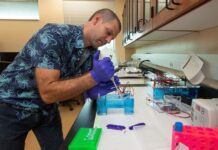
There is the potential for a new aquatic invader in the waters surrounding the Florida Keys.
Pulse corals are bright-colored soft corals that are very popular in the saltwater aquarium trade. Common native soft corals in the U.S. are sea fans, sea whips and sea pens. The pulse corals can be identified apart from our native soft corals because the polyps are much larger and the polyps are constantly opening and closing to feed in a pulsing rhythm.
Like the invasive lionfish, pulse corals are also native to the Red Sea and the Indo-Pacific Ocean. Since the temperatures in the Florida Keys are like their native range, there is good reason to believe if they arrive, they could be very successful at spreading rapidly if not controlled at once. Pulse corals were introduced illegally in Venezuela 20 years ago and the invasion there has devastated thousands of acres of coral reef and seagrass meadows.
In the past two years, another species has been found in northern Cuba and Puerto Rico. Pulse corals can smother coral reefs and seagrasses because they grow rapidly and have no known native predators.

Since the early 2000s, there have been numerous outbreaks of pulse corals in both the Pacific and Caribbean. The suspected causes of these outbreaks include intentional releases by marine aquarists, illegal aquaculture activities where they were likely grown in the wild to be sold in the aquarium trade, fragments of soft corals attaching to boats, ships and fishing gear, and possibly spread via ship ballast water.
Due to their asexual reproduction, removal is difficult without fragmenting and accidentally spreading these octocorals to new areas to colonize. As of 2024, invasive soft corals have been identified in Venezuela, Pearl Harbor, Hawaii (2020), Cuba (2022) and Puerto Rico (2023). These soft corals are very popular in the saltwater aquarium trade where they are known by the common names “Pulsing Xenia” and “Pom-Pom Xenia.” This is such a popular saltwater aquarium soft coral because it grows rapidly, can handle a wide range of poor water quality conditions and is easily fragmented and sold online to other aquarists with a high price range for colorful specimens.
Soft corals are soft and flexible compared to the hard stony corals that build coral reefs. Soft corals may also be called gorgonians from Greek mythology and the Gorgon Medusa, who had a head of writhing snakes. They are also called octo-corals because each individual polyp has eight symmetrical feathery tentacles. Hard corals like brain corals, star corals and pillar coral are distinguished by having six tentacles and secrete a hard calcium carbonate skeleton that creates the three-dimensional structure of a coral reef.
As we have seen with the invasive lionfish, aquatic invaders are very difficult to eradicate if they are allowed to become established. This is why we are looking for scuba divers and snorkelers to keep an eye out and report it if found. If you see it, please do not touch it, since small fragments easily break off and float away to regrow in new areas. Please send all reports to the U.S. Geological Survey Nonindigenous Aquatic Species “report a sighting” tool at https://nas.er.usgs.gov/SightingReport.aspx or to the Atlantic and Gulf Rapid Reef Assessment (AGRRA) Unomia Learning Exchange portal. Both of these sites have maps to drop a pin with latitude and longitude information and a place to upload photos.
The Monroe County Extension is working closely with both of these partners, and you can always call our office at 305-292-4501 or email monroe@ifas.ufl.edu with reports.

















